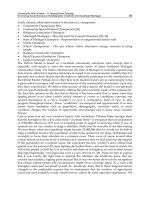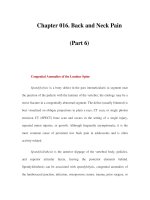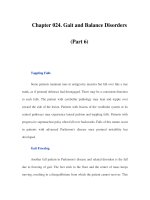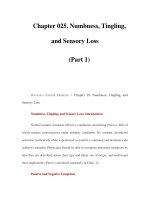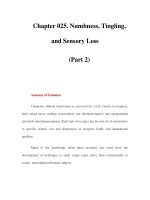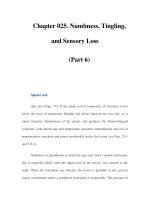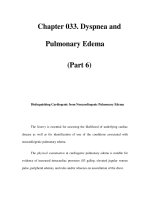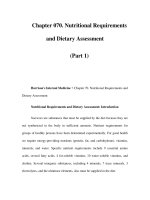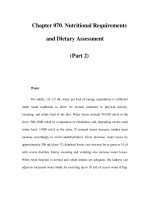Chapter 070. Nutritional Requirements and Dietary Assessment (Part 6) pps
Bạn đang xem bản rút gọn của tài liệu. Xem và tải ngay bản đầy đủ của tài liệu tại đây (15.85 KB, 7 trang )
Chapter 070. Nutritional Requirements
and Dietary Assessment
(Part 6)
Acute Care Settings
Acute care settings, anorexia, various diseases, test procedures, and
medications can compromise dietary intake. Under such circumstances, the goal is
to identify and avoid inadequate intake and ensure appropriate alimentation.
Dietary assessment focuses on what patients are currently eating, whether they are
able and willing to eat, and whether they experience any problems with eating.
Dietary intake assessment is based on information from observed intakes; medical
record; history; clinical examination; and anthropometric, biochemical, and
functional status. The objective is to gather enough information to establish the
likelihood of malnutrition due to poor dietary intake or other causes and to assess
whether nutritional therapy is indicated.
Simple observations may suffice to suggest inadequate oral intake. These
include dietitians' and nurses' notes, the amount of food eaten on trays, frequent
tests and procedures that are likely to cause meals to be skipped, nutritionally
inadequate diet orders such as clear liquids or full liquids for more than a few
days, fever, gastrointestinal distress, vomiting, diarrhea, a comatose state, and
diseases or treatments that involve any part of the alimentary tract. Acutely ill
patients with diet-related diseases such as diabetes require assessment because an
inappropriate diet may exacerbate these conditions and adversely affect other
therapies. Abnormal biochemical values [serum albumin levels <35 g/L (<3.5
mg/dL); serum cholesterol levels <3.9 mmol/L (<150 mg/dL)] are nonspecific but
may also indicate a need for further nutritional assessment.
Most therapeutic diets offered in hospitals are calculated to meet individual
nutrient requirements and the RDA. However, there are exceptions including clear
liquids, some full liquid diets, and test diets, which are inadequate for several
nutrients and should not be used, if possible, for more than 24 h. As much as half
of the food served to hospitalized patients is not eaten, so it cannot be assumed
that the intakes of hospitalized patients are adequate. Dietary assessment should
compare how much and what food the patient has consumed with the diet that has
been provided. Major deviations in intakes of energy, protein, fluids, or other
nutrients of special concern for the patient's illness should be noted and corrected.
Nutritional monitoring is especially important for patients who are very ill
and who have extended lengths of stay. Patients who are fed by special enteral and
parenteral routes also require special nutritional assessment and monitoring by
physicians with training in nutrition support and/or dietitians with certification in
nutrition support (Chap. 73).
Ambulatory Settings
The aim of dietary assessment in the outpatient setting is to determine
whether the patient's usual diet is a health risk in itself or if it contributes to
existing chronic disease-related problems. Dietary assessment also provides the
basis for planning a diet that fulfills therapeutic goals while ensuring patient
adherence. The outpatient dietary assessment should review the adequacy of
present and usual food intakes, including vitamin and mineral supplements,
medications, and alcohol, as all of these may affect the patient's nutritional status.
The assessment should focus on the dietary constituents that are most likely to be
involved or compromised by a specific diagnosis, as well as any comorbidities that
are present. More than one day's intake should be reviewed to provide a better
representation of the usual diet.
There are many ways to assess the adequacy of the patient's habitual diet.
These include a food guide, a food exchange list, a diet history, or a food
frequency questionnaire. A commonly used food guide for healthy persons is the
USDA's food pyramid, which is useful as a basis for identifying inadequate
intakes of essential nutrients, as well as likely excesses in fat, saturated fat,
sodium, sugar, and alcohol (Table 70-3). The guide is available online
(www.MyPyramid.gov) and can be tailored to the needs of persons of different
ages and life stages by varying the number of servings. The process of reviewing
the guide with patients helps to identify food groups eaten in excess of
recommendations or in insufficient quantities and helps them to transition to
healthier dietary patterns. For those prescribed therapeutic diets, assessment
against prescriptions stated as food exchange lists may be useful. These include,
for example, the American Diabetes Association food exchange lists for diabetes,
or the American Dietetic Association food exchange lists for renal disease.
Table 70-3 My Pyramid: The USDA Food Guide Pyramid for Healthy
Persons
Servings and
Examples of Standard
Portion Sizes
Lower:
1600 kcal
Moderate:
2200 kcal
Higher:
2800 kcal
Fruits, cups 1.5 2 2.5
Servings and
Examples of Standard
Portion Sizes
Lower:
1600 kcal
Moderate:
2200 kcal
Higher:
2800 kcal
Vegetables, cups 2 3 3.5
Grains, oz eq 5 7 10
(1 slice bread, 1 cup
ready to eat cereal, 0.5 cup
co
oked rice, pasta, cooked
cereal)
Meat and beans, oz eq 5 6 7
(1 oz lean meat,
poultry, or fish; 1 egg, 1 Tbsp.
peanut butter, 0.25 cup cooked
dry beans, or 0.5 oz nuts or
seeds)
Servings and
Examples of Standard
Portion Sizes
Lower:
1600 kcal
Moderate:
2200 kcal
Higher:
2800 kcal
Milk, cups 3 3 3
(1 cup milk or yogurt,
1.5 oz natural or
2 oz
processed cheese)
Oils, tsp 5 6 8
Discretionary calorie
allowance, kcal (remaining
calories after accounting for
all of the above)
132 290 426
Abbreviation: oz eq, ounce equivalent.
Source: Data from United States Department of Agriculture.
